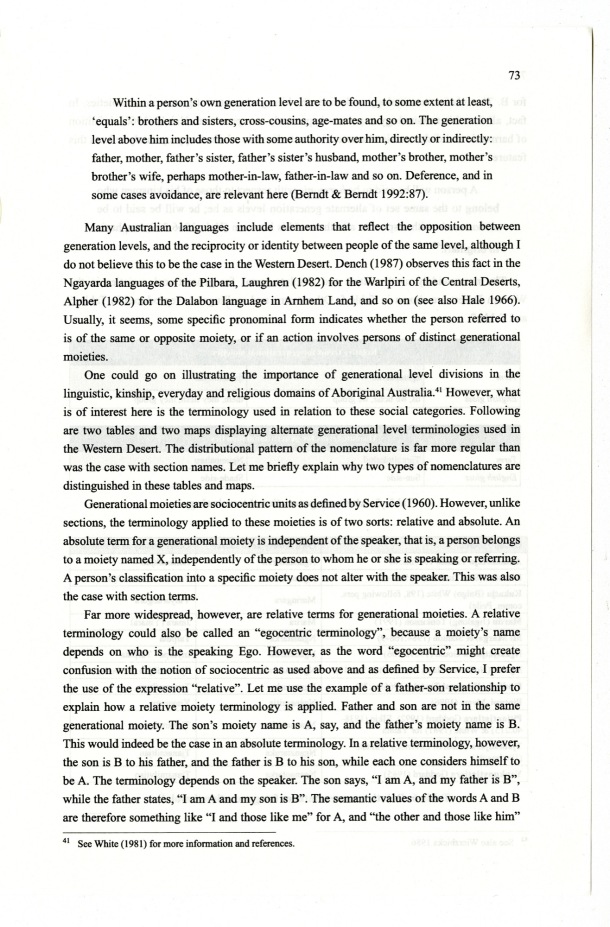|
| 
[Note: this transcription was produced by an automatic OCR engine]
73
Within a person’s own generation level are to be found, to some extent at least,
‘equals’: brothers and sisters, cross-cousins, age-mates and so on. The generation
level above him includes those with some authority over him, directly or indirectly:
father, mother, father's sister, father’s sister’s husband, mother’s brother, mother’s
brother’s wife, perhaps mother-in-law, father-in-law and so on. Deference, and in
some cases avoidance, are relevant here Bemdt Berndt 1992187.
Many Australian languages include elements that reflect the opposition between
generation levels, and the reciprocity or identity between people of the same level, although I
do not believe this to be the case in the Westem Desert. Dench 1987 observes this fact in the
Ngayarda languages of the Pilbara, Laughren 1982 for the Warlpiri of the Central Deserts,
Alpher 1982 for the Dalabon language in Arnhem Land, and so on see also Hale 1966.
Usually, it seems, some specific pronominal form indicates whether the person referred to
is of the same or opposite moiety, or if an action involves persons of distinct generational
moieties.
One could go on illustrating the importance of generational level divisions in the
linguistic, kinship, everyday and religious domains of Aboriginal Australia.“ However, what
is of interest here is the terminology used in relation to these social categories. Following
are two tables and two maps displaying alternate generational level terminologies used in
the Western Desert. The distributional pattern of the nomenclature is far more regular than
was the case with section names. Let me briefly explain why two types of nomenclatures are
distinguished in these tables and maps.
Generational moieties are sociocentric units as defined by Service 1960. However, unlike
sections, the terminology applied to these moieties is of two sorts: relative and absolute. An
absolute term for a generational moiety is independent of the speaker, that is, a person belongs
to a moiety named X, independently of the person to whom he or she is speaking or referring.
A person’s classification into a specific moiety does not alter with the speaker. This was also
the case with section terms.
Far more widespread, however, are relative terms for generational moieties. A relative
terminology could also be called an “egocentric terminology”, because a moiety’s name
depends on who is the speaking Ego. However, as the word “egocentric” might create
confusion with the notion of sociocentric as used above and as defined by Service, I prefer
the use of the expression “relative”. Let me use the example of a father-son relationship to
explain how a relative moiety terminology is applied. Father and son are not in the sanre
generational moiety. The sons moiety name is A, say, and the father’s moiety name is B.
This would indeed be the case in an absolute terminology. In a relative terminology, however,
the son is B to his father, and the father is B to his son, while each one considers himself to
be A. The terminology depends on the speaker. The son says, “I am A, and my father is B”,
wh.ile the father states, “I am A and my son is B”. The semantic values of the words A and B
are therefore something like “I and those like me" for A, and “the other and those like him”
4‘ See White 1981 for more information and references.
|